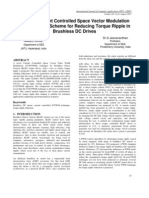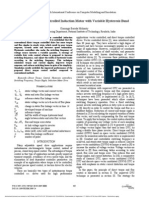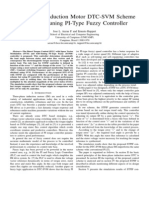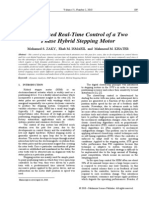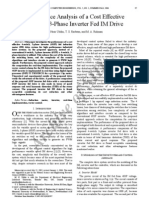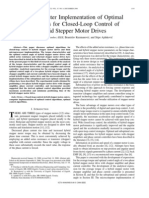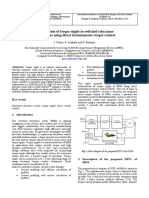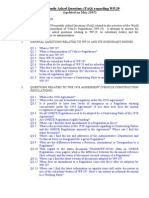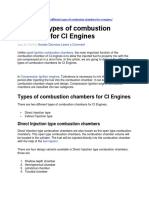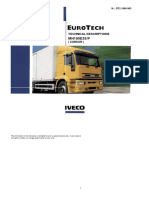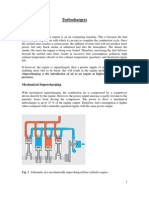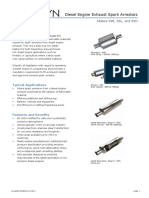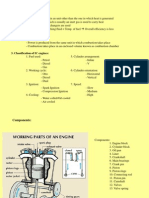Engine Torque Ripple Cancellation With An Integrated Starter Alternator in A Hybrid Electric Vehicle: Implementation and Control
Engine Torque Ripple Cancellation With An Integrated Starter Alternator in A Hybrid Electric Vehicle: Implementation and Control
Uploaded by
stefanovicana1Copyright:
Available Formats
Engine Torque Ripple Cancellation With An Integrated Starter Alternator in A Hybrid Electric Vehicle: Implementation and Control
Engine Torque Ripple Cancellation With An Integrated Starter Alternator in A Hybrid Electric Vehicle: Implementation and Control
Uploaded by
stefanovicana1Original Description:
Original Title
Copyright
Available Formats
Share this document
Did you find this document useful?
Is this content inappropriate?
Copyright:
Available Formats
Engine Torque Ripple Cancellation With An Integrated Starter Alternator in A Hybrid Electric Vehicle: Implementation and Control
Engine Torque Ripple Cancellation With An Integrated Starter Alternator in A Hybrid Electric Vehicle: Implementation and Control
Uploaded by
stefanovicana1Copyright:
Available Formats
In Proc.
of IEEE IAS Annual Meeting, Pittsburgh, Oct 11-19, 2002
Engine Torque Ripple Cancellation with an Integrated Starter
Alternator in a Hybrid Electric Vehicle: Implementation and Control
Roy I. Davis
Robert D. Lorenz
Associate Member, IEEE
Ballard Electric Drives and Power Conversion
15001 Commerce Drive North
Dearborn, MI 48121
rdavis9@ford.com
Fellow, IEEE
Departments of Mechanical Engineering
And Electrical and Computer Engineering
University of Wisconsin, Madison
Madison, WI 53711
lorenz@engr.wisc.edu
Abstract Integrated starter alternators (SA) allow greater
electrical generation capacity and the fuel economy and
emissions benefits of hybrid electric automotive propulsion.
The drive usually comprises a field-oriented induction motor or
vector-controlled permanent magnet motor coupled to the
crankshaft of the engine directly or by a belt. These drives have
high bandwidth torque control and may be used for active
cancellation of the significant ripple torque inherent to internal
combustion engines. This paper presents an analytical model
useful for the analysis of the combustion engine torque and
describes a control system that uses observer-based high fidelity
torque feedforward and engine speed feedback to generate a
disturbance input decoupling torque command for the SA to
cancel the engine torque ripple.
II. INTERNAL COMBUSTION ENGINE MODEL
An indirect injection four-cylinder diesel engine was used
for this research. A novel engine model was developed
consisting of a method for generating the combustion
pressure pulses for each of the four cylinder pressures, a
simplified representation of the slider-crank kinematics to
convert the pressure pulses to indicated torque, and a timevarying (or crankangle-varying) inertia expression to
represent the translating pistons as effective rotational
inertias. Fig. 1 shows an overall diagram of the engine,
clutch, and vehicle model, assuming the four cylinder
pressures P1() P4() as inputs, with the engine and vehicle
motion states as outputs. The indicated torque, MICE, as a
function of crankangle () can be expressed as
Index Terms Observer, integrated starter alternator,
engine torque, engine model, torque cancellation, active
flywheel, hybrid vehicle.
I. INTRODUCTION
Integrated starter alternators (SA) provide greater electrical
generation capacity and improve the fuel economy and
emissions of hybrid electric vehicles [1]. The integrated
starter alternator (SA) is coupled to the combustion engine
either directly or by a belt. In addition to enabling the fuel
economy and emissions improvements, the availability of the
SA to perform other functions provides further benefit to the
vehicle. One such function is active crankshaft torque ripple
cancellation, in which the SA machine is controlled as a
torque actuator to reduce or eliminate the ac content of the
torque produced by the impulsive cylinder pressures in the
engine [2, 3]. This is sometimes referred to as active
flywheel, although it does much more than a flywheel could
do.
This paper presents a "disturbance input decoupling"
control method using a highly accurate observer that
combines feedforward and feedback signals to synthesize the
torque control signal for the SA effectively to cancel the
ripple torque of the engine. The paper also describes a novel
internal combustion engine (ICE) model, the ac torque
observer used to create the SA control signal, and test results
that illustrate the system performance.
r
r
MICE () = k1 k2 ( 1.0+ cos()) - k3 ( 1.0- cos())
L
L
where
k1 =
(1)
B2rsin()
; k2 = P1()+P3(); k3 = P2()+P4();
4
and B is the cylinder bore, r is the crank radius, and L is the
connecting rod length.
MSA
P1 + P4
P2 + P3
Kinematics
Friction
Model
M ICE
_
MSHAFT
_ _
Jf + J( )
1
S
1
S
Variable
Inertia
1 J()
2
+
+
MCLUTCH
bcl
+
+
kcl
1
JV
Clutch
Model
_
1
S
1
S
_
M ROAD
Vehicle
Load
Fig. 1. Combined Engine, Clutch Damper, and Vehicle Model
It is important to include the crankangle-varying engine
inertia J() to properly model the dynamics of the crankshaft
torque.
The nonlinear geometry of the slider-crank
mechanism shown in Fig. 2 gives rise to two effects: an
inertia which is a function of the angle and a LaGrangian
term proportional to the partial derivative of the inertia and
the square of crankshaft speed [4]. These expressions are
given in (2) and (3), and are shown schematically in the
block diagram of Fig. 1. Depending on the relative
contribution, a friction torque term can also be included if
desired.
mrecr4
mrecr4
- 2mrecr2cos(2) cos(4)
2L2
2L2
J()
2mrecr4
= 4mrecr2sin(2) +
sin(4)
L2
(2)
(3)
where mrec is the total reciprocating mass.
With an eye toward real-time implementation of this
model as an observer, as described in the next section, a
simple but accurate method is required to compute the
impulsive cylinder pressures. The torque ripple that is
generated by the pressure pulses is considered here as a
disturbance input. Thus it is important to represent the
pressures as accurately as possible without relying on
complicated derivations of gas dynamics and chemical
thermodynamics [5-8].
The combustion pressure waveform can be accurately
modeled by considering the underlying mechanisms at work
in the cylinder. That is, by adding a motoring pressure
waveform due simply to the change in cylinder volume as the
crank rotates (without combustion), to an incremental
pressure waveform produced by combustion of the fuel. The
cylinder volume as a function of crankangle and the
resulting motoring pressure can be computed from
B
4
Motoring Prototype
Waveforms
Pzero14()
Pzero23()
RPM
FLVR
p23()
Motoring
Factor
c1
Firing
Factor
c2
P2()+P3()
+
+
Offset Pressure
P1()+P4()
p14()
Firing Prototype
Waveforms
p0(N)
Fig. 3. Simulation Block Diagram for Final Cylinder Pressure Model
( r + L - rcos()-
L - r sin ())
(4)
10
(5)
n
V()
(Vd+Vc))
12
P(0)
P() =
(6)
A block diagram showing this computation is given in Fig. 3.
Figure 4 shows very good matching of measured and
simulated pressure waveforms using this model.
where Vc is the cylinder clearance volume and Vd is the cylinder
displaced volume. P(0) is the intake manifold pressure.
12
1000 RPM - 10% FLVR
0
0
90
180
..
270
360
12
10
12
2500 RPM - 10% FLVR
0
0
Fig. 2. Geometry of Slider Crank Mechanism
90
180
.
270
90
180
..
270
360
2500 RPM - 50% FLVR
10
+ xp
1000 RPM - 30% FLVR
10
V() = Vc +
p(, N, FLVR) = pzero()c1(N) + p() c2(N, FLVR) + po(N)
J() = 2mrecr2 +
The motoring pressure waveform will differ only in
amplitude as a function of engine speed. By normalizing
these waveforms, a motoring prototype waveform, pzero(),
and a scaling factor c1 that is a function of speed, N, can be
found from experimental motoring data. The component of
cylinder pressure due to combustion is very difficult to
determine analytically. By capturing cylinder pressure
waveforms while the engine is firing at different fueling
levels (FLVR), and subtracting the appropriately phased
motoring waveform for each cylinder, a series of incremental
pressure waveforms due to the combustion of a known
amount of fuel is collected and analyzed. This analysis leads
to a similar firing prototype waveform, p(), and a scaling
factor c2 that is a function of speed, N, and fueling level,
FLVR. These prototype waveforms and scaling factors are
combined to compute individual cylinder pressure
waveforms at any speed and any fueling level as
360
90
180
.
270
360
Figure 4. Simulated [ _ ] & Measured [] Pressures (MPa) vs. Crankangle
III. ENGINE TORQUE OBSERVER DESIGN
300 VDC
To implement the "disturbance input decoupling" control,
a measurement or estimate of the torque ripple is required. It
is impractical due to expense and other issues to install a
physical sensor for crankshaft torque, so an observer is
designed to compute a non-lagging estimate of the engine
torque ripple (or ac torque). The control strategy is to
command the SA to produce the inverse of this ripple torque
which, when added to the crankshaft torque, will cause the
ripple to be cancelled or decoupled from the net output. It is
also important not to have the SA producing any average (or
dc) torque, so the observer is designed to capture an
estimate of only the ac content of the crankshaft torque.
The engine model described above must be extended to
include the contribution of the starter alternator torque.
Using this extended model as an observer, it is then possible
to determine the appropriate ac torque to use as the
"disturbance input decoupling" control signal, MAC . The
observer topology is shown in Fig. 5 in general terms, and in
detail in Fig. 6. The primary torque production process is the
internal combustion engine, while the secondary torque
production process is the SA. It is vitally important with this
technique to include the effects of both physical processes to
achieve a correct estimate, and to accurately represent the
complete physical system in the observer. As seen in both
Figs. 5 and 6, the command provided to the physical system
(the SA) must also be provided to the representation of the
SA in the observer. The determination of this signal, MAC , is
the primary result of this work.
Finally, because the feedforward portion of the observer is
open loop, motion state feedback from the physical system is
used in the observer to make it closed loop. This corrects for
any inaccuracies in the feedforward estimate [9, 10]
according to the bandwidth of the observer controller.
Torque
Control
Inputs
Disturbance Torque
Primary
+
Torque
Load
+_
Primary Torque
Production
Process
Secondary Torque
Production
Process
OBSERVER SYSTEM
Secondary
Torque
Estimate
Secondary Torque
Production
Process Model
Secondary
Load Model
M1
+
Observer
Controller
+
Load Model
FLVR
PWM
IGBT
Inverter
IFO
Current Regulator
(10 kHz)
MSA
1.8L IDI Engine
SA
Model
_ Jf + J()
1 J()
kio*Ts*z
z-1
kpo +
+
P1 + P4
P2 + P3
kdo*(z-1)
0.0015*z - 0.0005*z
+
1
bac
MICE
Jf + J()
1 J()
2
Ts*z
z-1
12
Friction
Model
Observer System with
Water Brake Load
(Executes at fs = 1.0 kHz)
Fig. 6.
Mac
+
Engine
Kinematics
Model
2 _
Ts*z
z-1
+
_
Combustion
Process
Model
SA
Induction
Machine
bWATER
BRAKE
Extended Crankshaft Torque Observer and AFW Controller
Implementation Block Diagram
Transfer function analysis is used here to tune the closed
loop observer, as has been done in previous work [11]. The
transfer function to analyze is that between the indicated
torque, MICE, and the observer output, MAC . This transfer
function is given in (7) and the corresponding Bode plot is
shown in Fig. 7 (with parameter variation included). Fig. 7
clearly shows that the output MAC is equal to MICE in the
desired passband, approximately 1 to 100 Hz, and attenuated
elsewhere, particularly at dc. This produces the desired
signal for decoupling the ac disturbance torque using active
flywheel control.
MAC(s)
=
MICE(s)
(7)
2
kdos + kpos + kio
2
2
Js + b
Js + b
(J s+b +1) +
b ac (kdos + kpos + kio) + kdos + kpos + kio
J s+b
J s (J s + b ac)
IV. ENGINE TEST STAND AND RESULTS
Disturbance Torque Estimate
for DID Control
Primary Torque
Production
Process Model
...
Measured
State(s)
Secondary
Torque
Primary
Torque
Estimate
IFO Controller
(Executes at
fs = 10 kHz)
Estimated
State(s)
Fig. 5. Extended Observer Topology for Active Vibration Control
The control system described above has been implemented
on a test stand consisting of a Ford 1.8 liter turbocharged
inter-cooled four-cylinder indirect injection diesel engine
with an indirect field-oriented induction motor starter
alternator directly coupled to the crankshaft where the
flywheel would normally reside. A water brake is provided
as a load. The test apparatus is shown schematically in Fig.
8. The field-oriented induction motor control block diagram
is shown in Fig. 9 [16, 17].
A significant amount of testing was carried out over the
speed range of idle (850 rpm) to 2000 rpm, under loaded and
unloaded conditions. Typical results for the observer and the
active flywheel performance are shown in Figs. 10 13.
Figs. 10 and 11 show a sample of the very good tracking
performance of the observed cylinder pressures, indicated
and net torque, and engine speed signals. Figs. 12 and 13
show a sample of the results achieved for the active flywheel
control using the starter alternator and the developed
observer.
V. CONCLUSIONS
This paper presents a simple method to actively control a
starter alternator to decouple unwanted ac disturbance torque
from internal combustion engines. The method is based on a
flexible and accurate dynamic model of an internal
combustion engine that is valid over all speeds and loading
conditions. The model is extended to develop an observer
capable of providing a very high fidelity, wide bandwidth
estimate of the crankshaft ripple torque content that can be
used as a disturbance input decoupling control signal for a
crankshaft mounted integrated starter alternator.
The
observer contains a feedback controller operating on
crankshaft speed feedback derived from the position sensor
used for the starter alternator control, such that no additional
sensors are required to implement this torque control system.
Test results are provided, showing very good performance
both for the observer and the active flywheel control system.
Linear Magnitude
1.5
0.5
4Lr N
iqse* +
N
3PLm2
D
_
D
idse*
*
1
+
Lm
vqse*
M*
0
0.01
0.1
10
3
1 10
100
90
PI
Rotate
PI
_
SLIP = f(r, M*,*)
Phase [degrees]
60
vqss*
vdse*
je
SLIP
e
vdss*
+
idse
30
idss
60
90
0.01
0.1
10
Frequency [Hertz]
Figure 7. Bode Plot of
MICE(s)
for bac =0.2 (___), 0.4(- - -),and 0.1 (. . .)
Cylinder Pressures
Indicated Torque
5 Pressures
Kistler Amplifiers(5)
Trigger
National
Instruments'
AT-MIO-16
ACE
IGBT
Inverter
300 V
Battery
200
2
-200
0
Dell 486/66MHz
PC
EEC-V
400
N-m
Abs Pressure, MPa
Fuel Control
Laptop PC
with
Xmath
A/D
_
_
Nm-rad
sec
Operator
Control Panel
Shaft Position
Fig. 9. Indirect Field Oriented Induction Machine Control Block Diagram
MAC(s)
SA
A/D
iass
ibss
icss
10 kHz Inner Loop Control Software
3
1 10
100
VDC
PWMA Inverter
PWM
PWMB
Duty
Cycle
PWMC
Quad.
Enc.
P/2
3
to
2
Rotate s
e -je iqs
iqse
2
*
to vbs
3
vcs*
r
+
30
0
vas*
200
400
600
Net Torque
180
360
540
720
Engine Speed
1.8L IDI
Diesel Engine
EEC-V: Electronic Engine Controller - 5th Generation
ACE: Advanced Controller for Electric Machines
IDI: Indirect Injection
IGBT: Insulated Gate Bipolar Transistor
SA: Starter Alternator
PC: Personal Computer
Daikin
Clutch
Process
Water
Clutch
Pedal
Signal
12 Volt Line
300 Volt Line
Torque Path
Fig. 8. Schematic Representation of The Engine Test Stand with SA and
Instrumentation
200
900
100
850
RPM
Fuel
Water
Brake
N-m
12V
Battery
Encoder
Kistler Pressure
Transducers
SA Machine
Load Control Valve
800
-100
750
-200
700
-300
180 360 540 720
Crankangle, Degrees
650
0.1
Time, Seconds
Fig. 10. Observer Test Results, 850 RPM, No Load:
Measured (....); Observer (___); Measured Speed (- - -)
0.2
Cylinder Pressures
Indicated Torque
Abs Pressure, MPa
N-m
Abs Pressure, MPa
Measured Cyl. Pressures
400
200
0
2
-200
0
200
400
600
180
360
540
4
2
720
Engine Speed
Net Torque
180 360 540 720
Crankangle, Degrees
Engine Speed
Net Torque
400
2060
1520
200
2040
1500
1480
180 360 540 720
Crankangle, Degrees
2000
0.02
0.04 0.06 0.08
Time, Seconds
0.1
Fig. 11. Observer Test Results, 1500 RPM, 20% FLVR:
Measured (....); Observer (___); Measured Speed (- - -)
Measured Cyl. Pressures
Engine Speed - Passive
950
900
4
RPM
Abs Pressure, MPa
850
2
800
0
0
750
0
180 360 540 720
Crankangle, Degrees
0.1
Time, Seconds
Engine Speed
950
200
900
RPM
N-m
Net Torque
400
850
800
-200
0
180 360 540 720
Crankangle, Degrees
750
2020
-200
1440
0
0
-100
1460
-200
RPM
100
N-m
RPM
N-m
200
0.05
0.1
0.15
Time, Seconds
Fig. 12. Observer & AFW Test Results, 850 RPM, No Load:
Measured Pressures (___); Measured (. . ..) and Observed (___)
Torque; Measured (- - -) and Observed (___) Speeds
-300
0
180 360 540 720
Crankangle, Degrees
1980
0
0.02
0.04
Time, Seconds
0.06
Fig. 13. Observer & AFW Test Results, 1500 RPM, 20% FLVR: Measured
Pressures (___); Measured (. . ..) and Observed (___) Torque; Measured (- -) and Observed (___) Speeds
VI. ACKNOWLEDGEMENT
[9]
The authors wish to acknowledge the motivation provided
by the Wisconsin Electric Machines and Power Electronics
Consortium (WEMPEC) of the University of WisconsinMadison, and the financial support of the Ford Motor
Company.
Luenberger, David G., "An Introduction to
Observers," IEEE Transactions on Automatic Control,
Vol. AC-16, No. 6, December 1971, pp. 596-602.
[10]
Gopinath, B., "On the Control of Linear Multiple
Input-Output Systems," The Bell System Technical
Journal, Vol. 50, No. 3, March 1971, pp. 1063-1081.
[11]
Rizzoni, Giorgio, "Estimate of Indicated Torque from
Crankshaft Speed Fluctuations: A Model for the
Dynamics of the IC Engine," IEEE Transactions on
Vehicular Technology, Vol. 38, No. 3, August, 1989,
pp. 168-179.
[12]
Rizzoni, Giorgio, Yue-Yun Wang, and Sergey
Drakunov, "Estimation of Engine Torque Using
Nonlinear Observers in the Crank Angle Domain,"
ASME DSC-56, Advanced Automotive Technologies,
1995, pp. 189-193.
[13]
Kao, Minghui, and John J. Moskwa, "Nonlinear
Diesel Engine Control and Cylinder Pressure
Observation," ASME Journal of Dynamic Systems,
Measurement, and Control, Vol. 117, June, 1995, pp.
183-192.
[14]
Kao, M., and Moskwa, J.J., "Engine Load and
Equivalence Ratio Estimation for Control and
Diagnostics via Nonlinear Sliding Observers," Int.
Journal of Vehicle Design, Vol. 15, Nos. 3/4/5, 1994,
pp. 358-368.
[15]
Lorenz, R.D., "New Drive Control Algorithms (State
Control, Observers, Self-Sensing, Fuzzy Logic, and
Neural Nets)," Proc. of PCIM Conf., Sept. 3-6, 1996,
Las Vegas, NV, pp. 275-289.
[16]
Lorenz, R.D., Lipo, T.A. and Novotny, D.W., "Motion
Control with Induction Motors," IEEE Proceedings
Special Issue on Power Electronics and Motion
Control, Vol 82, No. 8, pp. 1215-1240, August, 1994.
[17]
Novotny, D.W., and Lipo, T.A., Dynamics and
Control of Induction Motor Drives, Clarendon Press,
Oxford, 1995.
VII. REFERENCES
[1]
Kassakian, John G., H-C. Wolf, J.M. Miller, and C.J.
Hurton, "The Future of Automotive Electrical
Systems," Proceedings of the IEEE Conference on
Automotive Electronics, Dearborn, MI, USA, October
1996, pp. 3-12.
[2]
Tashiro, Hiroshi, et al, "Vibration Damping Control
Apparatus for Vehicle," US Patent 5,537,967, July 23,
1996.
[3]
Kouadio, L.K., P. Bidan, M. Valentin, J.P. Berry, "S.I.
Engine Idle Control Improvement by Using
Automobile Reversible 'Alternator'," Proceedings of
the IFAC 13th Triennial World Conference, San
Francisco, CA, USA, Paper No. 8b-03 5, 1996, pp. 9398.
[4]
Heywood, John B., Internal Combustion Engine
Fundamentals, McGraw-Hill, Inc., 1988.
[5]
Winterbone, D.E., Thiraurooran, C., and Wellstead,
P.E., "A Wholly Dynamic Model of a Turbocharged
Diesel Engine for Transfer Function Evaluation," SAE
770124, 1977.
[6]
[7].
[8].
Dobner, D.J., "A Mathematical Engine Model for
Development of Dynamic Engine Control," SAE
800054, 1984.
Cook, J.A., and Powell, B.K., "Modeling of an
Internal Combustion Engine for Control Analysis,"
IEEE Control Systems Magazine, August, 1988, pp.
20-26.
Jensen, J.P., Kristensen, A.F., Sorensen, S.C.,
Houbak, N., and Hendricks, E., "Mean Value
Modeling of a Small Turbocharged Diesel Engine,"
SAE 910070, 1991.
You might also like
- TF Bosch VP44 Fuel Pump (Ver1)Document43 pagesTF Bosch VP44 Fuel Pump (Ver1)Carlos A Romero93% (40)
- Megane Diesel Diagrama Bosch EDC16C3 F9Q 730 2Document1 pageMegane Diesel Diagrama Bosch EDC16C3 F9Q 730 2Diego Filice100% (3)
- OptiBlend System Operation and Installation ManualDocument9 pagesOptiBlend System Operation and Installation ManualVijendra PanwarNo ratings yet
- DC Motor Speed Control Methods Using MATLAB - Simulink and Their Integration Into Undergraduate Electric Machinery CoursesDocument9 pagesDC Motor Speed Control Methods Using MATLAB - Simulink and Their Integration Into Undergraduate Electric Machinery CoursesWen ZJNo ratings yet
- Hägglunds CDI 2.7: The Multipurpose ToolDocument2 pagesHägglunds CDI 2.7: The Multipurpose ToolHandrito YudoNo ratings yet
- Practical Motor Starting E161 PDFDocument0 pagesPractical Motor Starting E161 PDFmicrefeeNo ratings yet
- 445 AndradaDocument5 pages445 AndradaNishant GoyalNo ratings yet
- PID Controller For A Two Quadrant Chopper Fed DC Motor DriveDocument5 pagesPID Controller For A Two Quadrant Chopper Fed DC Motor DriveSalman HabibNo ratings yet
- IJSC Vol2 Iss1 253 260 2 PDFDocument8 pagesIJSC Vol2 Iss1 253 260 2 PDFMd Mustafa KamalNo ratings yet
- A Dynamic Model For Automotive Engine Control AnalysisDocument7 pagesA Dynamic Model For Automotive Engine Control Analysisekitani6817No ratings yet
- Feedback Linearization of DC Motors - Theory and ExperimentDocument8 pagesFeedback Linearization of DC Motors - Theory and Experimenteubis_machado4370No ratings yet
- Energy Efficient Control of Three-Phase Induction Motor DriveDocument6 pagesEnergy Efficient Control of Three-Phase Induction Motor DrivenaserhashemniaNo ratings yet
- Bond Graph Modeling and Computer Simulation of Automotive Torque ConvertersDocument22 pagesBond Graph Modeling and Computer Simulation of Automotive Torque ConvertersPratik ShahNo ratings yet
- Modelling and Simulation of An EDM Die Sinking Machine (Kocher 1995)Document10 pagesModelling and Simulation of An EDM Die Sinking Machine (Kocher 1995)gouluNo ratings yet
- Speed Regulation An Induction Motor Using Reference Adaptive ControlDocument5 pagesSpeed Regulation An Induction Motor Using Reference Adaptive ControlAtakan OzturKNo ratings yet
- Sliding Mode Observer For Torque Control in Sensorless BLDC MotorDocument5 pagesSliding Mode Observer For Torque Control in Sensorless BLDC MotorIOSRjournalNo ratings yet
- Speed Regulation and Torque Ripple Minimization of Induction Motor by DTC With PI and Fuzzy Logic ControllerDocument6 pagesSpeed Regulation and Torque Ripple Minimization of Induction Motor by DTC With PI and Fuzzy Logic ControllerVijay KumarNo ratings yet
- A Study of Synchronous Motor Drive Using SFCDocument4 pagesA Study of Synchronous Motor Drive Using SFCBrian GuevaraNo ratings yet
- Furnace Boiler App8 7Document13 pagesFurnace Boiler App8 7e.bathiyaNo ratings yet
- A CD Rive Final StrategyDocument4 pagesA CD Rive Final Strategyjiwani87No ratings yet
- Tianchun Lin, Liuyi Chang, Wangyong Chao, Kongfan Wu: Brushless DC Motor Drive The Automatic Control of ClutchDocument4 pagesTianchun Lin, Liuyi Chang, Wangyong Chao, Kongfan Wu: Brushless DC Motor Drive The Automatic Control of ClutchYesuf EndrisNo ratings yet
- 907continuous & Discontinuous Conduction of DC MotorDocument21 pages907continuous & Discontinuous Conduction of DC MotorMary Morse0% (1)
- Ijetae 0812 25 PDFDocument10 pagesIjetae 0812 25 PDFvishiwizardNo ratings yet
- Speed Control of A Single Phase Induction Motor: Knob, Which Is CommonlyDocument16 pagesSpeed Control of A Single Phase Induction Motor: Knob, Which Is CommonlygalaxyNo ratings yet
- Efficiency Aspects of Vector Control Applied To Synchronous Reluctance MotorsDocument7 pagesEfficiency Aspects of Vector Control Applied To Synchronous Reluctance MotorsNeeraj GahlainNo ratings yet
- DC Motor CalculationsDocument10 pagesDC Motor Calculationsoctav12No ratings yet
- Motor CalculationsDocument8 pagesMotor CalculationssmhbNo ratings yet
- Direct Torque Control of Induction MotorsDocument6 pagesDirect Torque Control of Induction MotorsInternational Journal of Application or Innovation in Engineering & ManagementNo ratings yet
- Hydraulic Modeling of Torque ConvertersDocument8 pagesHydraulic Modeling of Torque Convertersserf007100% (1)
- Eddy Current MotorDocument3 pagesEddy Current Motorbijlwanr50% (2)
- Soft Starting and Braking Application For Squirrel-Cage Induction Motors Operating in Intermittent DutyDocument11 pagesSoft Starting and Braking Application For Squirrel-Cage Induction Motors Operating in Intermittent Dutyni60No ratings yet
- DSP-Based Experimental Rig With The Doubly-Fed Induction Generator ForDocument12 pagesDSP-Based Experimental Rig With The Doubly-Fed Induction Generator Fordebasis250No ratings yet
- A Technical Seminar Report On: P.Neeharika (08B21A02B5)Document9 pagesA Technical Seminar Report On: P.Neeharika (08B21A02B5)srinivas0276No ratings yet
- Experiment No. 09 - Speed ControlDocument6 pagesExperiment No. 09 - Speed Controlabheetpethe.scoe.entcNo ratings yet
- Fuzzy Logic Control of An Induction Generator As An Electrical BrakeDocument7 pagesFuzzy Logic Control of An Induction Generator As An Electrical BrakerajuNo ratings yet
- Disturbance Observer Based Current Controller For A Brushed DC MotorDocument6 pagesDisturbance Observer Based Current Controller For A Brushed DC MotorAji Brahma NugrohoNo ratings yet
- Speed Control of DC MotorDocument10 pagesSpeed Control of DC MotorYadira RocanoNo ratings yet
- Assessment of Direct Torque Control For Induction Motor DrivesDocument18 pagesAssessment of Direct Torque Control For Induction Motor DrivesGutta YaswanthNo ratings yet
- SFC OperationDocument10 pagesSFC OperationKelvin LiewNo ratings yet
- Parameter Determination of The BLDC MotorDocument4 pagesParameter Determination of The BLDC MotorHuynh Thanh AnhNo ratings yet
- (Journal of Electrical Engineering) A New High Speed Induction Motor Drive Based On Field Orientation and Hysteresis Current ComparisonDocument9 pages(Journal of Electrical Engineering) A New High Speed Induction Motor Drive Based On Field Orientation and Hysteresis Current ComparisonAugusto ThedoctorNo ratings yet
- A Novel Current Controlled Space Vector Modulation Based Control Scheme For Reducing Torque Ripple in Brushless DC DrivesDocument7 pagesA Novel Current Controlled Space Vector Modulation Based Control Scheme For Reducing Torque Ripple in Brushless DC DrivesKoukou AmkoukouNo ratings yet
- A Direct Torque Controlled Induction Motor With Variable Hysteresis BandDocument6 pagesA Direct Torque Controlled Induction Motor With Variable Hysteresis BandMuhammad SaadNo ratings yet
- Direct Torque Control of Induction Motor ThesisDocument5 pagesDirect Torque Control of Induction Motor Thesiscrystaljacksonnewhaven100% (2)
- Three-Phase Induction Motor DTC-SVM Scheme With Self-Tuning PI-Type Fuzzy ControllerDocument6 pagesThree-Phase Induction Motor DTC-SVM Scheme With Self-Tuning PI-Type Fuzzy Controllerjorgeluis.unknownman667No ratings yet
- DSP Control of Stepper MotorDocument5 pagesDSP Control of Stepper MotorAhmedHyderMohdNo ratings yet
- Bahçeşehir University: 111equation Chapter 1 Section 1212equation Chapter 2 Section 1Document10 pagesBahçeşehir University: 111equation Chapter 1 Section 1212equation Chapter 2 Section 1Wael M. AbulafiNo ratings yet
- Archive of SID: Performance Analysis of A Cost Effective 4-Switch 3-Phase Inverter Fed IM DriveDocument6 pagesArchive of SID: Performance Analysis of A Cost Effective 4-Switch 3-Phase Inverter Fed IM DrivePranav VyasNo ratings yet
- SteeringDocument9 pagesSteeringAshish SharmaNo ratings yet
- Advanced in Control Engineeringand Information ScienceDocument5 pagesAdvanced in Control Engineeringand Information ScienceLuemba DayzesNo ratings yet
- Application of Space Vector Modulation in Direct Torque Control of PMSMDocument4 pagesApplication of Space Vector Modulation in Direct Torque Control of PMSMenmnabilNo ratings yet
- Windows-1256 00349655Document8 pagesWindows-1256 00349655enmnabilNo ratings yet
- Pi Control System Based Speed Control of DC Motor Using MicrocontrollerDocument13 pagesPi Control System Based Speed Control of DC Motor Using MicrocontrollerAnkit BhardwajNo ratings yet
- Vector Control of A Permanent-Magnet Synchronous Motor Using AC-AC Matrix ConverterDocument11 pagesVector Control of A Permanent-Magnet Synchronous Motor Using AC-AC Matrix ConverterKushagra KhamesraNo ratings yet
- Closed-Loop Control of Hybrid Stepper Motor DrivesDocument7 pagesClosed-Loop Control of Hybrid Stepper Motor DrivesChanthu C NairNo ratings yet
- 18-EE-47 LCS LAB 11docxDocument8 pages18-EE-47 LCS LAB 11docxAsif AulakhNo ratings yet
- Harmonics and Torque Ripple Reduction of Brushless DC Motor (BLDCM) Using Cascaded H-Bridge Multilevel InverterDocument4 pagesHarmonics and Torque Ripple Reduction of Brushless DC Motor (BLDCM) Using Cascaded H-Bridge Multilevel InverterPidikiti Surendra BabuNo ratings yet
- Minimization of Torque Ripple in Switched Reluctance Motor Drives Using Direct Instantaneous Torque ControlDocument5 pagesMinimization of Torque Ripple in Switched Reluctance Motor Drives Using Direct Instantaneous Torque ControlAnel Bey TahirbegoviçNo ratings yet
- Non Linear System For DC MotorDocument6 pagesNon Linear System For DC MotorAhmad RahanNo ratings yet
- Control of DC Motor Using Different Control StrategiesFrom EverandControl of DC Motor Using Different Control StrategiesNo ratings yet
- Advanced Electric Drives: Analysis, Control, and Modeling Using MATLAB / SimulinkFrom EverandAdvanced Electric Drives: Analysis, Control, and Modeling Using MATLAB / SimulinkNo ratings yet
- Simulation of Some Power System, Control System and Power Electronics Case Studies Using Matlab and PowerWorld SimulatorFrom EverandSimulation of Some Power System, Control System and Power Electronics Case Studies Using Matlab and PowerWorld SimulatorNo ratings yet
- A Topology Based Approach For Exploiting Sparsity in Multibody Dynamics in Cartesian FormulationDocument18 pagesA Topology Based Approach For Exploiting Sparsity in Multibody Dynamics in Cartesian Formulationstefanovicana1No ratings yet
- Tank ComponentsDocument12 pagesTank Componentsstefanovicana1No ratings yet
- Tank Container Relief Vent Valve RV 30, RV 40 RV 30 RV 40: GestraDocument2 pagesTank Container Relief Vent Valve RV 30, RV 40 RV 30 RV 40: Gestrastefanovicana1No ratings yet
- Frequently Asked Questions (FAQ) Regarding WP.29: (Updated On May 2005)Document17 pagesFrequently Asked Questions (FAQ) Regarding WP.29: (Updated On May 2005)stefanovicana1No ratings yet
- Vehicle Sideslip and Roll Parameter Estimation Using GPSDocument8 pagesVehicle Sideslip and Roll Parameter Estimation Using GPSstefanovicana1No ratings yet
- Volvo Sept 2011 PV776-K-BodyBuilder Kit TOCDocument1 pageVolvo Sept 2011 PV776-K-BodyBuilder Kit TOCstefanovicana1No ratings yet
- Text With EEA RelevanceDocument26 pagesText With EEA Relevancestefanovicana1No ratings yet
- x3 CatalogueDocument10 pagesx3 Cataloguestefanovicana1No ratings yet
- Quattro The Evolution of Audi All-Wheel DriveDocument50 pagesQuattro The Evolution of Audi All-Wheel Drivestefanovicana1100% (1)
- 7series Sedan CatalogueDocument9 pages7series Sedan Cataloguestefanovicana1No ratings yet
- BWM 0000004 01Document54 pagesBWM 0000004 01stefanovicana1No ratings yet
- BWM 0000002 01Document28 pagesBWM 0000002 01stefanovicana1No ratings yet
- Adjoint Sensitivity Analysis For Differential-Algebraic Equations: The Adjoint Dae System and Its Numerical SolutionDocument14 pagesAdjoint Sensitivity Analysis For Differential-Algebraic Equations: The Adjoint Dae System and Its Numerical Solutionstefanovicana1No ratings yet
- Forward 4jb1 SeriesDocument75 pagesForward 4jb1 SeriesAsif JavedNo ratings yet
- Second Law Analysis If IC EnginesDocument16 pagesSecond Law Analysis If IC Enginesdjermounimohamed100% (1)
- Different Types of Combustion Chambers For CI EnginesDocument8 pagesDifferent Types of Combustion Chambers For CI EnginesM.Bilal noumaniNo ratings yet
- Volvo L70 FDocument36 pagesVolvo L70 Fsijith100% (1)
- Eurotech Mh190e35p Technical DescriptionsDocument29 pagesEurotech Mh190e35p Technical Descriptionsjadan tupuaNo ratings yet
- QSK 45GDocument25 pagesQSK 45Gvassindou67% (3)
- AMS (Training Objectives)Document8 pagesAMS (Training Objectives)Christian Cañon GenterolaNo ratings yet
- FD Series Gas Fume Diluter BrochureDocument2 pagesFD Series Gas Fume Diluter BrochureMisaghNo ratings yet
- FM 400 8X4 Tipper With 29 Cu.M Coal BodyDocument4 pagesFM 400 8X4 Tipper With 29 Cu.M Coal BodymaiquelernNo ratings yet
- Doosan Information TecnicaDocument2 pagesDoosan Information TecnicaAlfonso Alberto ArguelloNo ratings yet
- Turbo NotesDocument18 pagesTurbo NotescleousNo ratings yet
- Class5 Evs Lesson 12 What If It FinishesDocument7 pagesClass5 Evs Lesson 12 What If It Finisheslalitarani_05100% (2)
- DS-Chalwyn-Spark Arrestors 0118 Rev1 PDFDocument8 pagesDS-Chalwyn-Spark Arrestors 0118 Rev1 PDFLai Yoong LeiNo ratings yet
- Get TRDocDocument96 pagesGet TRDocashishgoel102No ratings yet
- QCS-2010 Section 21 Part 17 Standby Diesel Generator SetDocument16 pagesQCS-2010 Section 21 Part 17 Standby Diesel Generator Setbryanpastor10650% (2)
- Teknik Kendaraan Ringan OtomotifDocument5 pagesTeknik Kendaraan Ringan OtomotifSupriyadi donopawiroNo ratings yet
- Department of Education: Republic of The PhilippinesDocument16 pagesDepartment of Education: Republic of The PhilippinesJheng Delos Reyes PantojaNo ratings yet
- Maintenance Manual For WP12 Diesel EngineDocument137 pagesMaintenance Manual For WP12 Diesel EngineВиталий ЩурNo ratings yet
- Engines:: 1. External CombustionDocument16 pagesEngines:: 1. External Combustionlrgs92No ratings yet
- Engine Starting Systems-EnG32760Document64 pagesEngine Starting Systems-EnG32760Yasmine ياسمينNo ratings yet
- Technical Data D2866LXE30 2011 04 11Document3 pagesTechnical Data D2866LXE30 2011 04 11kamalNo ratings yet
- Impact of Late and Early Fuel Injection On Main Engine Efficiency and Exhaust Gas EmissionsDocument5 pagesImpact of Late and Early Fuel Injection On Main Engine Efficiency and Exhaust Gas EmissionsRyandri YudiantoNo ratings yet
- Mobilgard™ 300: Diesel Engine System OilDocument2 pagesMobilgard™ 300: Diesel Engine System OilSanath WijerathneNo ratings yet
- Hilux BrochureDocument25 pagesHilux Brochurekideo614100% (1)
- Siemens Turns Focus To Gasoline Injection: Automotive Is One of The Leaders in ThisDocument10 pagesSiemens Turns Focus To Gasoline Injection: Automotive Is One of The Leaders in ThissinasayedanaNo ratings yet
- Industrial - MarineDocument28 pagesIndustrial - MarineSuprastowo Bin SarinoNo ratings yet









































